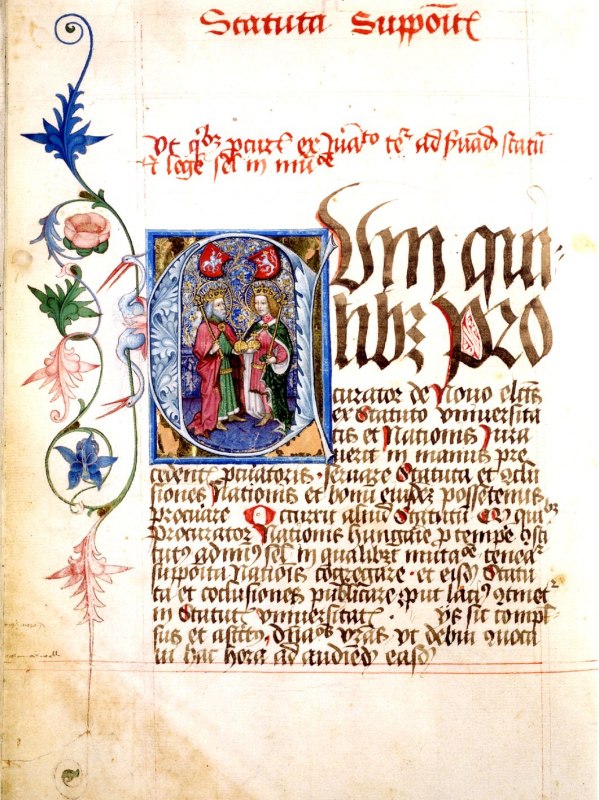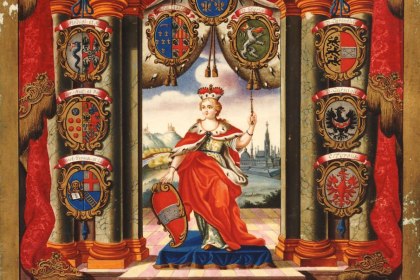An early “mass university”
The University of Vienna not only is one of the oldest north of the Alps and east of the Rhine, from the end of the 14th to the beginning of the 16th century it also had the highest number of students in this area.
Current university statistics reveal, among other things, the national or regional origin of their students, with an international composition being seen a sign for a high attraction and thus for high quality of the university.
How was this handled in the Middle Ages? Did the university even record the origin of their students? Are regional focuses noticeable and did these change over time?
The University of Vienna – like other medieval universities as well – in general had no regional restrictions on the admission of students. The universitas magistrorum et scholarium, the community of teachers and students, was open to all Christian men born in wedlock. Despite this general openness each university of course had regional focuses in regards to the composition of their students.
The second university in Central Europe
The University of Vienna was founded in 1365 and was, after the University of Prague (founded in 1347), only the second university in Central Europe to be continuously operational. Close to this – both geographically and temporally – universities were also established in Cracow (1364) and in Pécs (1367), but both of these were completely or at least partially disbanded within a few years of their opening. In the 1380s a first wave of university foundations swept over the area of the Holy Roman Empire, followed by two more at the beginning and middle of the 15th century. Due to Vienna’s head start it was able to establish itself as an important university for students from the empire.
Matriculation by academic nations
The entries in the Viennese rector’s register (Matrikel) paint a rough picture of the regional composition of the university attendees. The people listed were divided into academic nations. Classifying students into regional entities and calling these units nations was common practice at the universities, as is already pointed out in the founding letter of 1365. There were differences in the number and designation of these nations.
In Vienna there were four nations: the Austrian nation included people from the Austrian hereditary lands (Erbländer) as well as from Aquileia, Churwalchen and Italy. The Rhenish nation covered the South and the West of the empire, while university members from the Lands of the Crown of St. Stephen, as well as from Bohemia, Moravia and the Greek area belonged to the Hungarian nation. The Saxon nation, finally, included – apart from the eponymous Saxons – people from the British Isles and Scandinavia.
Vienna – an attraction for students from Southern and Western Germany as well as from Austria
The division by nations in the main register began in 1385. From that year until 1519 a total of 49,745 persons were entered into the register. The Rhenish and the Austrian nation formed the two largest groups with 45% (22,056 persons) and 34% (16,398 persons) respectively. The Hungarian and the Saxon nation lagged behind with 18% (8,743 persons) and 3% (1,405 persons) respectively.
Particularly from the matriculations of members of the Rhenish nation one can deduce changes in the university landscape of the empire. Until 1450 there were no universities in Southern and Southwestern Germany. Apart from Vienna there were only a few other universities in the empire: Erfurt (founded 1379), Heidelberg (1385), Cologne (1388), Leipzig (1409) and Rostock (1419). With the exception of Heidelberg, all of these universities were located in Northern and Northwestern Germany.
Accordingly, a high influx of students from the Rhenish nation can be noted for this time: Almost half of all students, 49% (9,061 persons) belonged to it. The Austrian nation, the second largest group, counted only 24% of students (4,478 persons), half the number of the Rhenish nation, as its members. The Hungarian nation had about the same number of members, 22% (4,141 persons), while the Saxons came in last with only 5% of students (994 persons).
From the middle of the 15th century more and more universities were founded in Southern Germany. Students from this area could now also attend the universities in Freiburg im Breisgau (1457), Basel (1459), Ingolstadt (1459) or Tübingen (1476). This wider range of university locations is reflected in the changed composition of the Viennese student body: the Rhenish and the Austrian nation were now equally large with 44% (12,260 persons) and 40% (11,530 persons) respectively, while the percentage of Hungarians remained more or less the same with 15% (4,474 persons). The number of Saxons fell to 1% (394 persons), which can be traced back to the establishment of universities in Northern Germany, Scandinavia and the British Isles.
The university register as a reflection of current events
Not only the changes in the European university landscape, but also (more short-term) political or other events left their marks in the frequency of matriculations. Between 1461 and 1463 the matriculations of students from the Austrian nation dropped drastically, while no significant changes can be seen among members of the other nations. This drop in Austrians is a result of a dispute between Frederick III and his brother Albert VI over the allocation of the Austrian lands. The altercations between Frederick and the Hungarian king Matthias Corvinus are also reflected in short-term frequency changes, this time in the Hungarian nation: During the siege of Vienna 1477 the matriculation numbers declined in general, but especially among members of the Hungarian nation. When Matthias had relocated his residency to Vienna after its capture in 1485, the matriculation numbers of Hungarian students remained relatively stable, but after the king’s death in 1490 they again dropped for a short time.
Few Viennese among the university attendees
Although the members of the Austrian nation formed the second largest group of university attendees in the Middle Ages, Viennese students were a minority. Until 1519 only 1.73% (841 persons) of all matriculated students came from the city itself. One can only speculate about the reasons for the university’s low attraction for the city’s population. One reason certainly was that the university and its members were considered somewhat of a foreign body in the city: They had their own judicial system independent of that of the city and were entitled to other privileges, such as exemptions from customs and taxes. Even though the “priest city” (“Pfaffenstadt”) planned by Rudolf IV – a city within the city separated by a wall – never was realized, a university neighborhood at the Stubentor emerged in the Middle Ages. The close proximity of the city’s inhabitants and the university members, who made up about 10% of the total population of medieval Vienna, repeatedly led to conflicts which were resolved in various ways. Some were decided in court, where the legitimacy of privileges was discussed, but some were decided in violent altercations between students and city residents. For some Viennese, this constant readiness for conflict might have been an argument against joining the university.
This changed drastically in the 16th century: The percentage of Viennese students rose steadily, until they formed the majority of the matriculations. However, this is also a result of the matriculation numbers dropping dramatically from the 1520s onwards, which almost threatened the university’s existence.
Zuletzt aktualisiert am 11.10.2024 - 10:32


